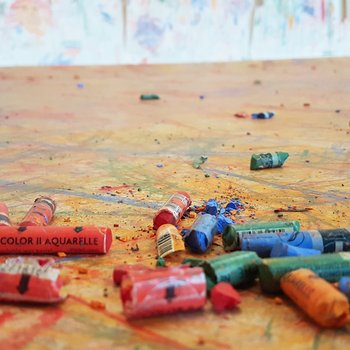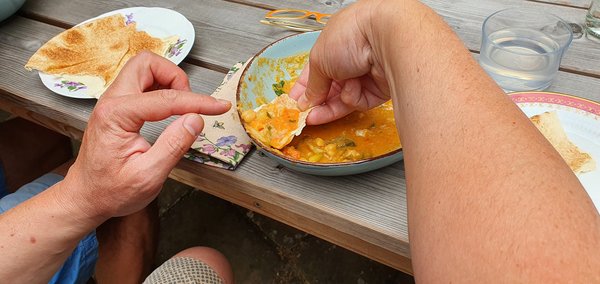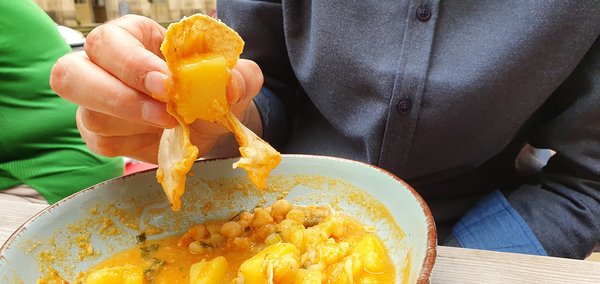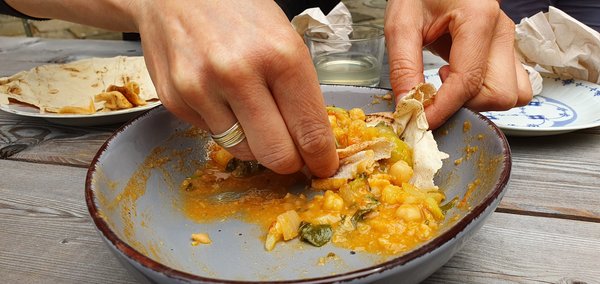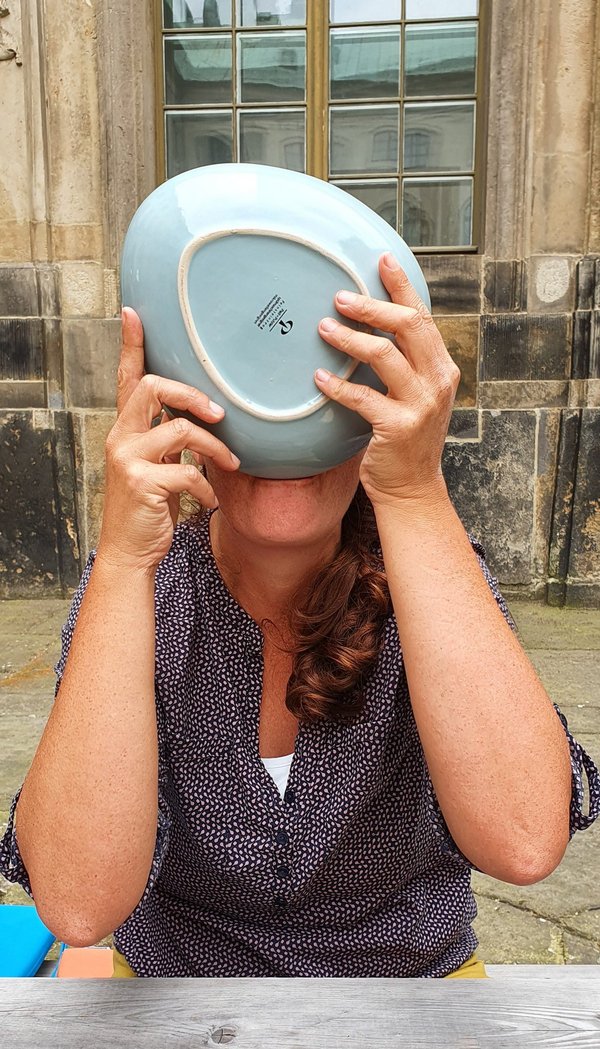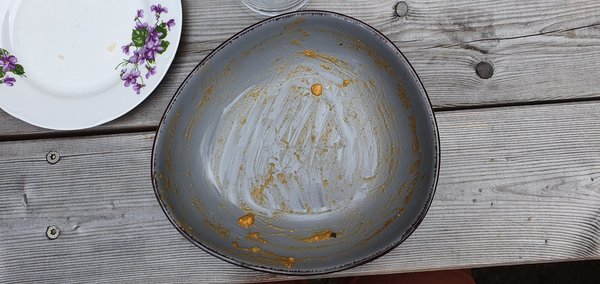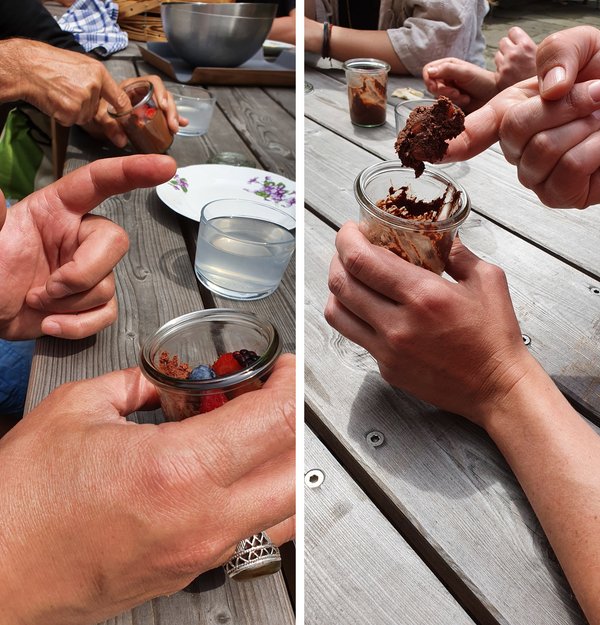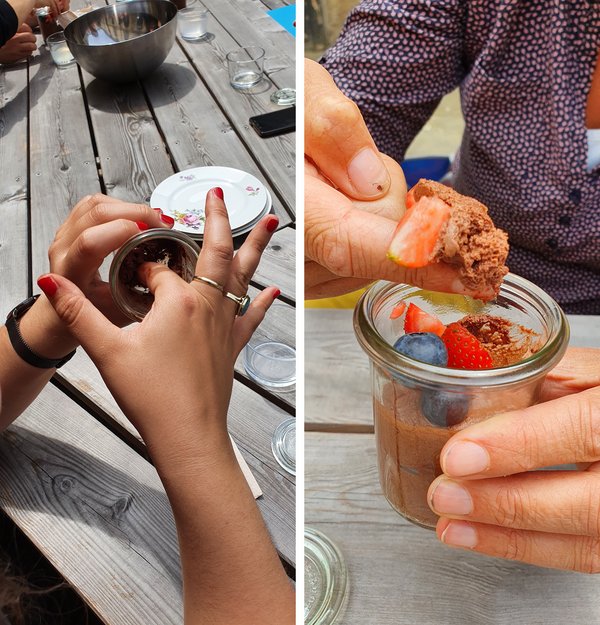Jeden Freitag versammelt sich im Hof des Japanischen Palais eine Gruppe von 20 bis 30 Gästen, um gemeinsam Mittag zu essen und dabei ins Gespräch zu kommen. Die Anmeldung erfolgt per E-Mail, oft stoßen allerdings auch vereinzelte Spontanbesucher*innen dazu und erfragen Restplätze. Lunch for Locals heißt die Veranstaltung, bei der das Palais Café seine Gäste kostenlos verköstigt. Das Café stellt seine Kochkünste dabei ganz in den Dienst der Nachhaltigkeit. Vieles kommt aus dem Palais-eigenen Garten, Zero-Waste ist der Anspruch und Kreisläufigkeit ein zentrales Motiv. Gegebenenfalls anfallender Papiermüll wird in einer Kompostanlage des Gartens den Würmern zum Fraß vorgeworfen. Die machen daraus Erde, in der wiederum wachsen kann, was die Besucher speisen. Idealerweise bleibt nichts zurück, erst recht kein Plastikbesteck.
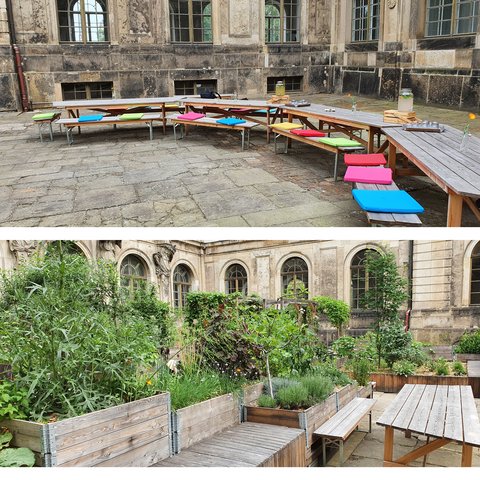
Spoon Archaeology meets Lunch for Locals, 2022
© Staatliche Kunstsammlungen Dresden, Foto: Jacob Franke
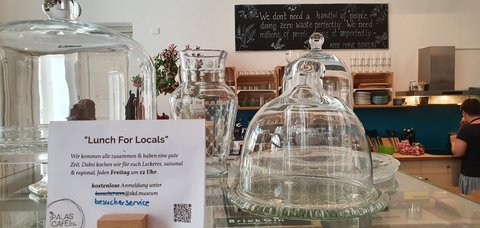
Spoon Archaeology meets Lunch for Locals, 2022
© Staatliche Kunstsammlungen Dresden, Foto: Jacob Franke
Die Anliegen des Palais Cafés und der Ausstellung Spoon Archaeology liegen dementsprechend nah beieinander und so wurde man sich schnell darüber einig, dass im Format Lunch for Locals passende Mahlzeiten zur Ausstellung eingenommen werden könnten. Am Freitag den 20. 05. fand nun der erste von zwei Terminen statt, an denen mit den Händen gegessen wird. Das mag für Verfechter*innen der gepflegten Tischkultur barbarisch anmuten, allerdings ist es global gesehen eher der Standard. Und selbst hier, im Land der Kuchengabel, gibt es Speisen, die man sich ganz selbstverständlich händisch einverleibt. Von der Bratwurst im Brötchen, über das Eis in der Waffel, bis hin zum Döner oder Falafel sind gerade im Bereich Street-Food die Hände auch in Deutschland ein verbreitetes Esswerkzeug.
Bei dieser Ausgabe des Lunch for Locals wurde allerdings ein Curry serviert, eine sämige Soße mit allerlei Gemüse darin. Außerdem gab es in großen Glasspendern ganz hervorragende Sommer-Limonaden, eine mit Löwenzahn und eine mit Lavendel und Flieder. Als Sättigungsbeilage, wie man das in der Unimensa früher recht lustbefreit nannte, gab es flache, runde Brotfladen, die allerdings nicht nur dem Verzehr, sondern auch der Beförderung des Currys vom Teller zum Mund dienten.
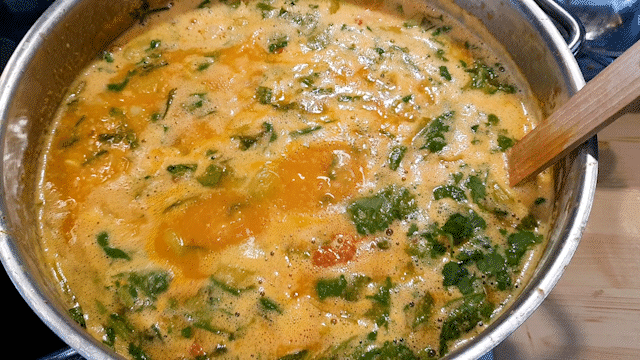
Spoon Archaeology meets Lunch for Locals, 2022
© Staatliche Kunstsammlungen Dresden, Foto: Jacob Franke
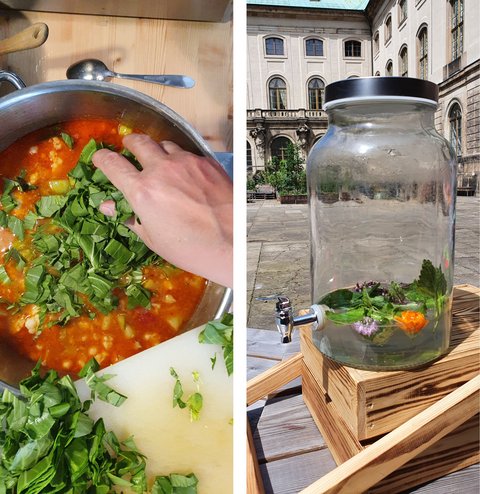
Spoon Archaeology meets Lunch for Locals, 2022
© Staatliche Kunstsammlungen Dresden, Foto: Jacob Franke
Die Gäste, die erst kurz zuvor über den Sondercharakter der Veranstaltung aufgeklärt wurden, nahmen die Herausforderung an. Es blieb ihnen schließlich auch nix anderes übrig, wenn sie ihren Hunger stillen wollten. Angesichts des zum Programm erklärten Bruchs mit den Tischsitten, war die Stimmung sehr schnell sehr freudvoll. Eis war nicht zu brechen, dafür aber die Brotfladen, in deren Einsatz sich schnell verschiedene Techniken entwickelten.
Nahmen viele die ersten Happen noch per ins Curry getunktem Brotsenker ein, entwickelte sich schnell die Benutzung einer Brotschaufel zum Standard. Einige setzten das Brot fingerfertig als eine Art Greifschutz ein, um damit einzelne Brocken aus dem Curry zu fischen, andere arbeiteten gar beidhändig nach einer Art Schaufel- und Feger-Prinzip. Alle Techniken führten dabei gleichermaßen ans Ziel, sodass am Ende wirklich jeder Teller restlos geleert war. Lob an die Gäste, Lob an die Küche, Lob auf die Hand.
Diese Art zu speisen hatte allerdings nicht nur soziale Effekte. Auch der Bezug zum Essen sei ein anderer, wurde von verschiedenen Gästen festgestellt. Man esse bewusster. Das ist auch kein Wunder, denn die Automatismen, mit denen wir uns unser Essen sonst einverleiben, sind plötzlich nicht mehr gültig, wenn wir nicht auf die klassischen Werkzeuge zurückgreifen können. Stattdessen wird jeder Happen zum Ergebnis komplexer strategischer Überlegungen. Wie groß sollte mein nächster Brotabschnitt sein, welche Form soll er haben? Und was will ich überhaupt als nächstes essen? Ein Stück Kartoffel? Eher Kleinteiliges mit Soße? Nur Soße? All das will wohl überlegt sein, bevor der passende Brotfetzen gerissen wird. Schnell stellt sich dabei ein besonderes Bewusstsein für den nächsten Happen ein. Der wird dann nicht mehr nur auf der Zunge geschmeckt und in der Nase gerochen, sondern begegnet auch dem Tastsinn. Das führt nicht nur zu bewussterem Essen, sondern auch zu einer sinnlicheren Erfahrung.
Zum Dessert schließlich wartete das Café augenzwinkernd mit einer besonderen Herausforderung auf: einer veganen Mousse au Chocolat (das Rezept gibt's weiter unten). Zwar war sie mit einigen Früchten garniert, doch die reichten bei Weitem nicht aus, um als Werkzeug zum Leeren des Servierglases genügen zu können. Nach dem Brot des Hauptgangs gab es nun also keinerlei distanzierendes Element mehr zwischen Hand und Essen und das Werkzeug der Werkzeuge konnte sich nun ganz in seiner Vielseitigkeit bewähren – nicht mehr nur reißend, schiebend, tunkend und greifend, sondern auch löffelnd. Die kulinarische Sensation der Mousse ließ sich dabei ebenso schwer von der Hand weisen, wie die schokoladige Masse selbst. Doch auch dafür haben wir glücklicherweise in der Hand das ideale Werkzeug und die ist – darin werden auch die eisernsten Verfechter*innen der Tischmanier zustimmen – nach dem Essen ohnehin zu waschen.
Das Lunch for Locals findet immer Freitagmittag im Japanischen Palais statt. Am 17. 06. 2022 wird ein weiteres Mal mit Händen gegessen. Die Anmeldung erfolgt via E-Mail.
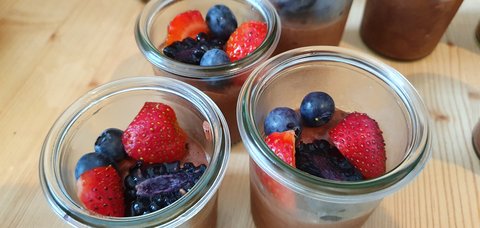
Spoon Archaeology meets Lunch for Locals, 2022
© Staatliche Kunstsammlungen Dresden, Foto: Jacob Franke
150 g Zartbitterschokolade (vegan)
150 ml Aquafaba (entspricht Wasser aus 1 Dose Kichererbsen)
1-2 EL Puderzucker
Prise Salz
___
1) Schokolade im Wasserbad schmelzen.
2) Aquafaba aus der Dose in eine Schüssel geben, die Priese Salz hinzufügen und mit einem Handrührgerät ca. 5 min steif schlagen.
3) Löffelweise den Puderzucker hinzufügen und weiterschlagen.
4) Am Schluss die abgekühlte flüssige Schokolade in die Schüssel geben und mit einem Teigschaber vorsichtig unterheben.
5) In vorbereitete Gläser oder Behälter nach Wunsch füllen und min. 1 h im Kühlschrank ziehen lassen.
Je nach Lust kann frisches Obst oder Fruchtsoße zum Garnieren verwendet werden. Die Mousse kann bis zu 5 Tage im Kühlschrank aufbewahrt werden.
Tipp: Die Schokolade sollte lauwarm, etwas abgekühlt und noch flüssig sein. Denn wenn sie zu warm ist, sackt der Schaum zusammen.
Auch interessant:
Einwegbestecke aus Plastik sind ein Symbol für die globale Wegwerfgesellschaft. Seit 3. Juli 2021 sind sie in der EU verboten. Die auf der Basis der Sammlung der Designer Peter Eckart und Kai Linke entstandene Ausstellung „Spoon Archaeology“ im Kunstgewerbemuseum greift das Thema auf.
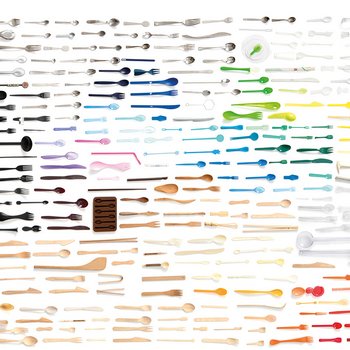
Kaum jemand in Deutschland kennt sich mit der Geschichte des Essens so gut aus wie Anna Dünnebier. In ihrem Beitrag erklärt sie unter anderem, wie vor der Etablierung des Löffels gegessen wurde und wie man einen solchen richtigerweise benutzt.
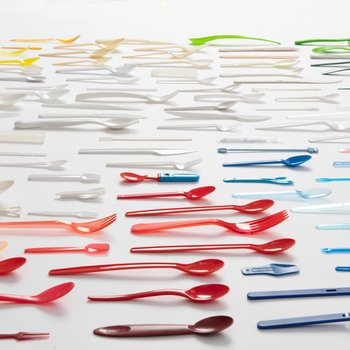
Was passiert, wenn man dem Museumspublikum einen Stapel Stifte, ein paar Blätter Papier und einen ganzen mit weißen Papieren ausgekleideten Raum zur Verfügung stellt? Der Dresdner Künstler Artourette hat das im Zuge der Kinderbiennale im Japanischen Palais getan.
